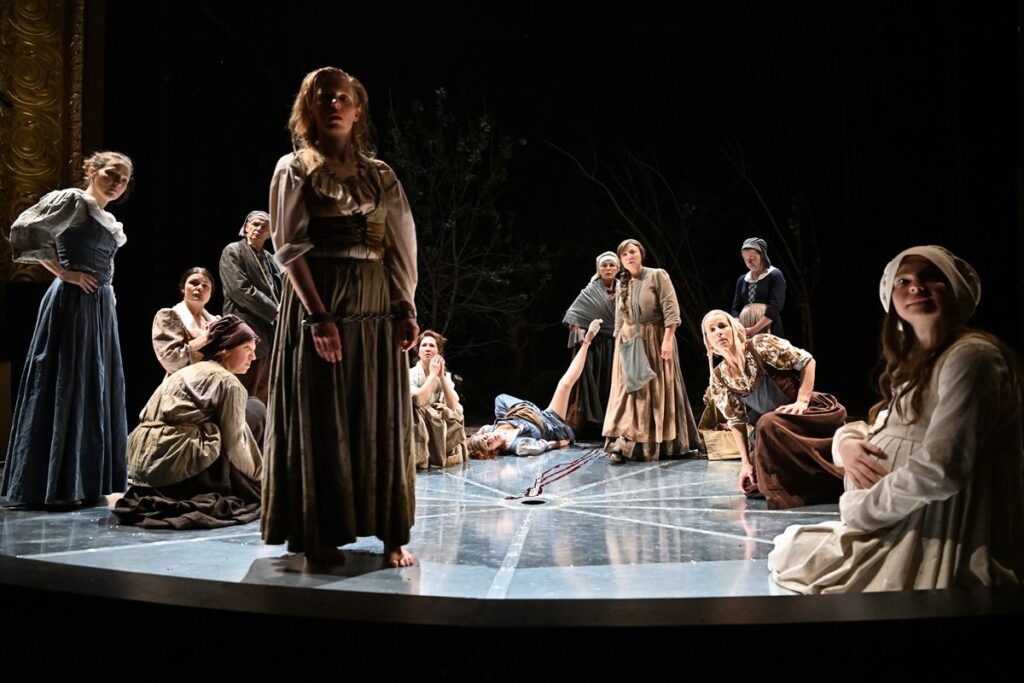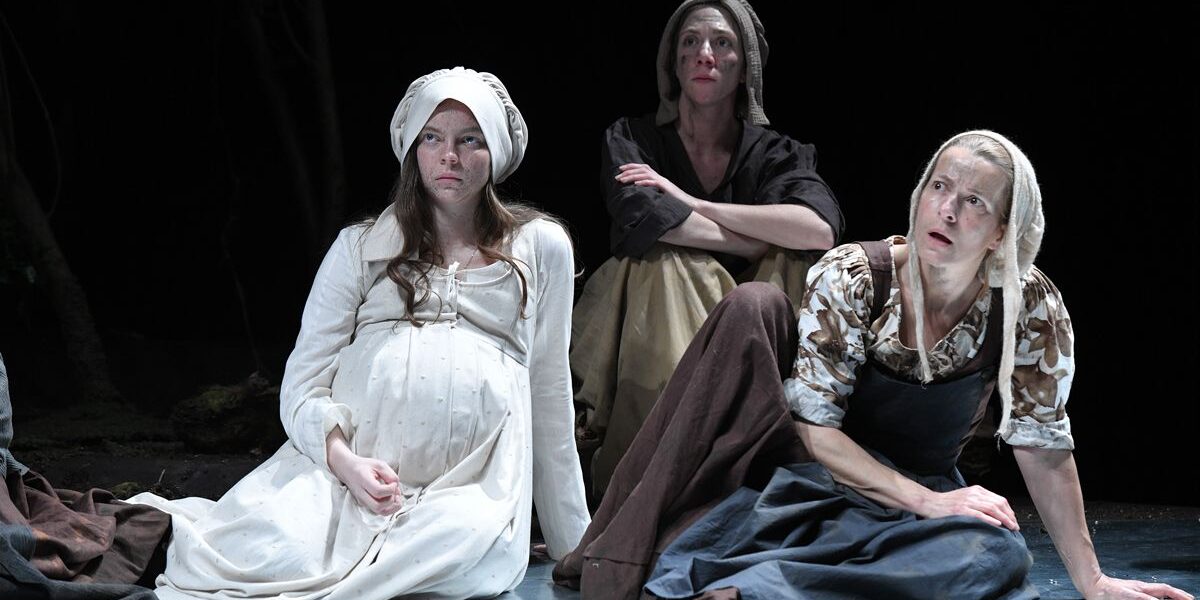SNG Drama Ljubljana, premiere 23rd March 2024
British playwright Lucy Kirkwood’s The Welkin is a play in which a woman – and her body – are judged. More to the point it is a play about how a woman’s body is judged, probed and policed in a world governed by men.
Premiering in London in 2020, the play is set in the 18th century, in rural Suffolk in the UK. The original text is full of archaic expressions, which might have made translation into Slovenian a challenge from a linguistic perspective, but thanks to a careful translation by Tina Mahkota and equally careful direction by Sebastijan Horvat, the production succeeds. Some of the language in Mahkota’s translation borders on vulgar, most often the language used when speaking about women’s bodies, but given the theme of the play, this feels apt.
Sally Poppy (played by Maruša Majer) has been accused of murder. However complications arise when it is revealed that Sally may be pregnant; whether or not she is pregnant or not weighs heavily on the case, as the sentence she would receive as a pregnant woman would exclude the death penalty. Twelve other women act as a jury – they will determine her fate.
Sally is a character we want to feel sympathy for, and yet she grasps at any opportunity to not allow us to feel that way about her; she is violent and noisy, she threatens the jury members. Majer performs these outbursts with intense energy. Her role as an antagonist is amplified by the fact that the murder she allegedly committed was the murder of a child. Her “natural, feminine, motherly” role (as women are not seldomly viewed as vessels for children and praised for being mothers – and motherly) is diminished, almost destroyed by the victim’s age. Although the other characters often interrupt her, Sally is the centre of attention. But with such a strong acting ensemble – consisting of actresses Nataša Barbara Gračner, Saša Pavček, Silva Čušin, Sabina Kogovšek, Iva Babić, Vanja Plut, Pia Zemljič, Nina Ivanišin, Eva Jesenovec, Maša Derganc, Zvezdana Mlakar, and Mina Švajger as well as the actors Igor Samobor and Nejc Cijan Garlatti – staying the centre of attention is not an easy task. Their performances, particularly those in which they convey the differences in the women’s personalities, are incredibly well-executed. The cast are maybe at their best in the scenes of overlapping speech between the characters. This is by far the strongest aspect of the production.

The Welkin, SNG Drama Ljubljana. Photo: Peter Uhan
Director Sebastijan Horvat creates an atmosphere of urgency, panic and determinism. Aleksandar Čavlek’ lighting is designed to be morbid and anxiety-inducing, especially as the actors’ faces are hard to see at some points in the play. This sense of murkiness is supported by Igor Vasiljev’s scenography, which gives off a somehow organically messy vibe, that is also recreated in the historically believable costumes (Belinda Radulović) which contain some modern pieces mixed in. The unclean faces of the performers add to that feeling, something we almost never see in historic films. While it might not be common for such a large number of women at that time in history to have such decisive and powerful roles, to see that in such a brutal display of deciding whether someone lives or dies – with all the voices being heard – is almost utopian.
The play is relatively long for the point it is (successfully) trying to get across. Though it runs to almost three hours, it does not feel as long as this, as the text is altered at some points and the deliveries are often fast-paced. Milan Ramšak Marković’s dramaturgy is extremely effective -the text is in some scenes is spoken in a way that is almost synchronized with the upcoming act. This chaotic dynamic can get tiring after a while, especially in relation to the dialogue. Fortunately the gestures and actions of the cast completely support the spoken word and add another layer. These densities and dilutions are very common through the performance. The audience’s attention is captured at once and then, just as quickly, released; its cyclical structure working on our ruined attention spans and overworked minds almost like we are toddlers and everything is fighting for our limited focus.
This is also a sign that our society is changing dramatically. The more we long for a slowdown, de-escalation, reduction, the faster and more overwhelming life gets. As the dramaturg Ramšak Marković puts it: “The text actually describes the beginning of a type of civilization, the end of which we are witnessing today.” The Welkin is immersive in its style and its story – and very political. To understand the end, we must understand the beginning. As the end of an era approaches, we cannot be truly ready for everything, but we can shape ourselves, us as individuals, to have strong identities, arguments, our own thoughts, to not be once again pressed as by a cookie cutter to fit within the societal mass.
Credits:
Author: Lucy Kirkwood//Translator: Tina Mahkota // Director: Sebastijan Horvat//Dramaturg: Milan Ramšak Marković
Set: Igor Vasiljev//Costume: Belinda Radulović//Composer: Drago Ivanuša//Lighting: Aleksandar Čavlek
Cast: Maruša Majer, Nataša Barbara Gračner, Saša Pavček, Silva Čušin, Sabina Kogovšek, Iva Babić, Vanja Plut, Pia Zemljič, Nina Ivanišin, Eva Jesenovec, Maša Derganc, Zvezdana Mlakar, Mina Švajger, Igor Samobor, Nejc Cijan Garlatti
For tickets and further information, visit: drama.si
Further reading: Sebastijan Horvat: “All the former Yugoslav countries have a kind of dementia”
Živa Kadunc is a critic of contemporary performance art and a speaker on Radio Študent (Slovenia). She loves her plants.








